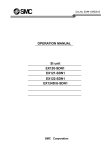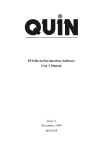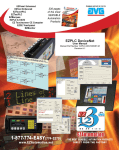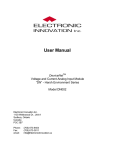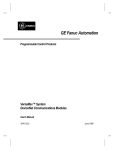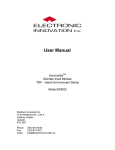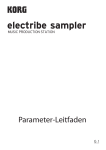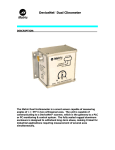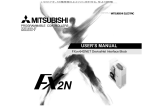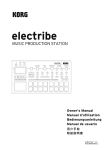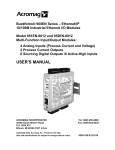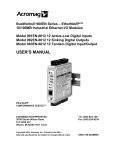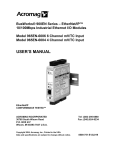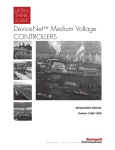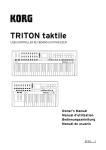Download NetComm User Manual
Transcript
Network Communicator NC100 DESCRIPTION:_____________________________ Add the convenience of wireless operator control to your DeviceNet* system using a NetComm 100 base unit. The NetComm 100 brings the flexibility and productivity of ergonomic remote control to complex DeviceNet* processes. Network Communicator 100 MODULE NETWORK I/O MODULE The NetComm 100 is a base radio that receives operator commands from a wireless handheld transmitter and makes them available as a DeviceNet* object. Using the NetComm 100 and a TriggerPad handheld, an operator can interact with a DeviceNet* system at a typical separation of 300 feet. This product is ideal for interactive systems, system maintenance, and automated processes that require occasional manual override. Wireless Operator Control NetComm TriggerPad Trunk Line Terminator Tap I/O BLOCK NODE SCANNER NODE MOTOR CONTROL NODE SENSOR NODE SPECIFICATIONS:___________________________ • • • • • • • • • • • • • • • • • • • • • • Standard DeviceNet* node Configuration using DeviceNet* Rugged aluminum enclosure Panel mount flange Supports a variety of Matric handstations 16 bit CPU with CPU watchdog Baud rate (125K, 250K, 500K) Powered by 11-24VDC +/- 5% (DeviceNet) Power consumption .66A at 11VDC worst case In range / Out of range indicator for site mapping Power indicator Network status indicator 900MHz one way radio with 8 channels Fragmented Explicit Messaging supported Operational range of 0 - 300 feet* Remote antenna mount up to 30 feet Size: 5 1/4 X 5 3/4 X 3 Inches Weight: 1 Lb 10 Oz Five pin male mini connector Operational temperature 0°C to 70°C Storage temperature -40ºC to 85ºC DeviceNet Product Catalog Number 941 *Typical specified range, actual range is dependent upon conditions and transmitter specs APPLICATION:______________________________ A variety of handhelds are available for the NetComm 100. The TriggerPad 100 includes four durable mechanical switches, which provide tactile feedback and over 1 million cycle operational life. The TriggerPad 105 features eight membrane switches and a two digit LED display. The TP-105 display can be used to set a value that is transmitted to the NetComm. The value is simply an additional byte of data along with the switch states that is available at the NetComm for use by the DeviceNet* scanner for application programming. Uses include setting a speed value, a count, or identifying what equipment the handheld can control. TriggerPad handhelds are made of rugged molded plastic, use durable switches (over 1 million cycles), and typically provide more than one month of battery life using standard AA batteries. A risk assessment should be performed before implementing any new control application. During risk assessments it should be noted that in applications that require emergency stop a different model of remote control or a different emergency stop method (pull cord, light curtain, etc.) should be employed. The Network Communicator employs 900 MHz radios that support 8 channels so that multiple independent systems can be implemented in relatively close proximity with one another as shown below. Refer to the “Placement” section of this manual for further details regarding RF proximity issues. TriggerPad on Channel X NetComm on Channel X TriggerPad on Channel Y NetComm on Channel Y DeviceNet* Trunk Line Multi-Channel Multi-Operator Application The NetComm 100 supports an open RF messaging scheme that simply responds to messages that provide the required header and CRC. RF messages that are received simultaneously cannot be interpreted and are ignored. This approach provides a high degree of data integrity and flexibility, but does not guarantee message reception or discriminate between the sources of received messages. Consequently, the NetComm 100 suitable for multi-operator applications, but does not provide the continuously maintained RF link required for emergency stop applications. TriggerPad TriggerPad TriggerPad NetComm DeviceNet* Trunk Line Single Channel Multi-Operator Application The actual range available at any given site is dependent upon a number of RF related variables. Structural components such as steel decking, earth tunnels, antenna placement, and metal walls or equipment can effect the quality of RF transmissions. Also, radiation sources such as other radio systems, high power switching, and magnetic fields can also effect the quality of RF transmissions. A site assessment should be performed at any site where any new RF control is to be installed. Refer to the “Placement” section for details regarding radio issues, site assessment, and optimal antenna placement. The NetComm 100 is housed in a sealed aluminum extrusion with flanges for panel mounting. The sealed enclosure allows the NetComm to be mounted in a control case or externally where it may be exposed to weather. A DeviceNet configuration/commissioning tool such as Rockwell’s RSNetWorx, DeviceView, or SST’s Node Commissioning Tool is required to prepare the NetComm for service. The NetComm conforms to the “Predefined Master / Slave Connection Set” as presented in the DeviceNet specification. In particular, the NetComm participates as a slave device in the I/O Poll Command / Response Message sequence. The NetComm ignores any data in the Poll Command and considers it a trigger to return a response. A poll response message containing four data bytes is sent from the NetComm (slave) to the scanner (master) in response to a poll command message. The poll response message contains the state of the handset buttons, the type of handset, the battery status, and a one byte value as detailed following field chart. The state of the handheld buttons is given in a bitmap form. The switch numbers of the bitmap correspond to the positions shown in the handset diagrams. Poll Response Message Byte 0 (Status): bit 7 - 1 = Low Battery in handheld bit 6 - 1 = Receiving Data bit 5 - not used bit 4 - not used bit 3 - not used bit 2 - not used bit 1 - not used bit 0 - not used Byte 1 (Button presses): bit 7 - Sw 8 bit 5 - Sw 6 bit 4 - Sw 5 bit 3 - Sw 4 bit 2 - Sw 3 bit 1 - Sw 2 bit 0 - Sw 1 Byte 2 (Decimal numerical value): 0 - 99 (as shown on TP-105 display) Byte 3 (Remote type): 00hex = TriggerPad 100 01hex = TriggerPad 105 1 2 1 2 4 3 3 7 5 4 8 6 TP-100 TP-105 CONFIGURATION:___________________________ All configuration of the Network Communicator is performed via DeviceNet* using a configuration device and explicit messages. Definitions of the objects used to operate the NC100 are given below. Once configured, the handset data is retrieved from the NC100 during a poll command-response sequence. Identity Object (Class 1, Instance 1): The Identity Object is used to get information (attributes) about the NC100. These attributes are read only. Attribute 1: Attribute 2: Attribute 3: Attribute 4: Attribute 5: Vendor ID: This attribute contains Matric’s ODVA vendor identification number, 229. Device Type: This attribute contains the ODVA device profile assigned to the NC100. The NC100 is considered type 24, Human-Machine Interface. Product Code: This is the part number of the NC100. The Matric part number is 500-0941 and the product code is 941. Revision: This attribute shows the version of this NC100 unit. Two bytes are used to contain the digits before and after the decimal place, ie Revision 1.1. Name: This attribute contains the ASCII characters of the product name, NetComm 100. DeviceNet Object (Class 3, Instance 1): The DeviceNet Object is used to get and set data pertaining to how the NC100 interfaces with the DeviceNet network. Attribute 1: Attribute 2: MAC ID: This attribute contains this unit’s unique address on the DeviceNet. It must be a value from 063 and the default setting as shipped is 63. Baud Rate: This value sets the baud rate of the NC100 and should match the baud rate of the network. The codes used to specify the baud rate are shown below. The default baud rate is 125K baud. 0=125K baud 1=250K baud 2=500K baud Assembly Object (Class 4, Instance 1): The Assembly Object collects the handset data used in the Poll Response Message. These attributes are read only. Attribute 3: Handset Data: This attribute contains the 4 bytes of data in the same structure described as the Poll Response Message. Parameter Object (Class 15, Instance 1): The Parameter Object contains configuration information required by a DeviceNet product. This object is used by the NC100 to configure the radio channel used to communicate with a handset. Attribute 1: RF Channel: This attribute is the radio channel used to communicate with a handheld transmitter. When used with a TriggerPad handheld it should be set to a value from 0-7 that corresponds to the handset being used. Vendor Specific Object (Class 100, Instance 1): The Vendor Specific Object contains information used by the NC100. This is an optional object and is included in this manual for reference purposes only. Attribute 1: Attribute 2: Attribute 3: RF Channel: This attribute is the radio channel used to communicate with a handheld transmitter. Temperature, Fahrenheit: This is the internal temperature of the NC100. This reading is not calibrated. Temperature, Celsius: This is the internal temperature of the NC100. This reading is not calibrated. Electronic Data Sheet (EDS) File: The EDS file for the NC100 is available on the Matric web site or can be emailed upon request. It is printed here for your convenience. $ [File] DescText = "Eds File for Netcomm 100"; CreateDate = 10-19-2000; CreateTime = 14:25:07; ModDate = 11-07-2000; ModTime = 10:17:26; Revision = 1.0; [Device] VendCode = 229; VendName = "Matric Limited Inc."; ProdType = 24; ProdTypeStr = "HMI"; ProdCode = 941; MajRev = 1; MinRev = 1; ProdName = "Netcomm 100"; Catalog = "500-0941"; [IO_Info] Default = 0x0001; $ Poll Only PollInfo= 0x0001, $ Poll Only 1, $ Default Input = Input1 1; $ Default Output = Output1 Input1 = 4, 0, 1, "Input1", 6, "20 04 24 01 30 3", "Data Input"; "No Output"; EDS File continued: Output1 = 0, 0, 1, "Output1", 6, "20 04 24 02 30 3", "No Output"; [ParamClass] MaxInst = 3; Descriptor = 0; CfgAssembly = 0; [Params] Param1 = 0, 6, "20 03 24 01 30 01", 0, 8, 1, "MacId", "Node", "Address", 0,63,63, 1,1,0,0, 0,0,0,0,0; Param2 = 0, 6, "20 03 24 01 30 02", 0x0002, 8, 1, "Baud", "Kbps", "Bit Rate", 0,2,0, 1,1,0,0, 0,0,0,0,0; EDS File continued: Param3 = 0, 6, "20 64 24 01 30 01", 0, 8, 1, "Rx Channel", "Channel", "Value", 0,7,1, 1,1,0,0, 0,0,0,0,0; [EnumPar] Param2 = "125 KB", "250 KB", "500 KB"; $ Enumeration Text for Baud Rate INDICATORS:______________________________ The NC100 provides three diagnostic L.E.D. indicators. The L.E.D. are labeled “Module”, “Network”, and “I/O”. The behavior of these indicators conforms to DeviceNet* and is described below. Refer to “The DeviceNet* Communication Model and Protocol” Chapter 8 for complete details regarding DeviceNet* states and indicators. Module Indicator In general, this indicator shows the status of the NC100 unit itself. For This State: The LED is: To Indicate: No Power Off Device Operational Green Device In Standby Flashing Green Minor Fault Flashing Red There is no power applied to the device. The device is operating in a normal condition. The device needs commissioning due to configuration missing, incomplete, or incorrect. The device has a recoverable fault. The device has an unrecoverable fault and may need to be replaced. The device is in self test. Unrecoverable Fault Red Device Self Testing Flashing Red/Green I/O Indicator In general, this indicator shows the status of communication between the NC100 unit and the handheld transmitter. For This State: The LED is: To Indicate: I/O Inactive Off Not used. Green Flashing Red The NC100 is receiving data from a handset. The NC100 is not receiving data from a handset. Not used. Red Not used. Flashing Red/Green Not used. Flashing Green Network Indicator In general, this indicator shows the status of the communication link between the DeviceNet* network and the NC100 unit. For This State: The LED is: To Indicate: No Power/ Not Online Off Online, Not Connected Flashing Green Link OK Green Connection Time Out Critical Link Failure Flashing Red Communication Faulted Flashing Red/Green There is no power applied to the device or the device has not yet completed power up testing. The device is online, but has no connections to other nodes. The device is online, and has connections to other nodes. One or more I/O connections have timed out. The device has detected an error that has rendered it incapable of communicating on the network. The device has detected a Network Access error and has received an Identify Communication Faulted Request – Long Protocol message. Red INSTALLATION:_____________________________ The NetComm 100 can be bolted directly to a control panel using the mounting flanges. See the diagram below for mounting dimensions. Antenna DeviceNet* 0.59 1.16 2.44 3.56 4.75 See Detail A for mounting hole dimensions 1.16 0.59 5.66 0.66 1.38 1.53 1.44 0.66 0.28 0.75 4.16 0.75 0.66 Detail A 5.06 0.30 0.30 The NetComm 100 provides a sealed male (pins) mini style connector that complies with the physical standards for DeviceNet* connectors. A DeviceNet* tap is used to interface to the DeviceNet* trunk line. The pinout for the connector is shown below. 5 4 1 2 3 1 - Drain 2 - V+ 3 - V4 - CAN_H 5 - CAN_L PLACEMENT:_______________________________ The NetComm 100 is an FSK radio receiver that operates in the 902928 MHz band. Eight channels are provided for separation in adjacent applications. Multiple transmitters may be active on separate channels so long as an adjacent channel’s signal does not enter the receiver at a level exceeding the rejection capability of the receiver. The effective rejection capability of the NetComm is dependent upon RF factors that vary from application to application. The rejection capability in a particular application may be determined through trial and error or through a comprehensive site assessment. A site assessment should be performed before any new radio system is introduced into an operating environment. A thorough site assessment of an area will discover active radio frequencies that could lead to contention and their sources. For optimal performance, the antenna for the NetComm should be mounted vertically, away from solid objects, and in the most visible line of sight from the normal transmitting area. THEORY OF OPERATION_____________________ The Network Communicator involves three basic components. The first component is a Radio Module that receives switch state messages from a handheld transmitter. The Processor forms the switch data into DeviceNet Objects that are made available via a DeviceNet Interface. TriggerPad Handheld Transmitter Switch State Processor Switch State Messages Radio Module DeviceNet Interface DeviceNet Objects Processor Switch State Messages Radio Module Transmission of Switch State Messages Switches DeviceNet Objects NetComm Unit DeviceNet APPROVALS:_______________________________ The NetComm 100 has been tested and found to comply with the limits for an intentional radiating device, pursuant to Part 15 of the United States FCC Rules. Changes or modifications not expressly approved by Matric could void the user’s authority to operate the NetComm 100. Matric 2099 Hill City Road Seneca, PA 16346 814-677-0716 www.matric.com NetComm 100 Manual v3.pub *DeviceNet is a registered trademark of ODVA Copyright 2001, Matric Printed in USA, 8/8/02




















